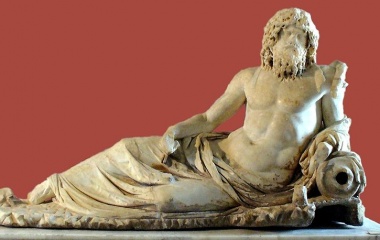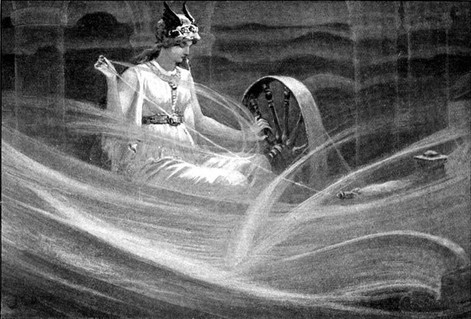The Shrine of Goddess Nemesis / The History of Romania in One Object
- RCI USA
- Oct 18, 2021
- 6 min read

Photo 1: The double representation of Goddess Nemesis
One of the most valuable artifacts exhibited at the Museum of National History and Archaeology in Constanța is the aedicula (a small shrine in ancient Roman religion) with a double representation of goddess Nemesis. This formidable piece is one of the 24 artifacts of the Sculpture Treasury discovered by chance, on April 1, 1962 (on Fool's Day), while the rails of the old station of the city were being removed. The piece is dated at the end of the 2nd century AD or the beginning of the 3rd century AD, in the time of the Severan dynasty.
In ancient Greek mythology Nemesis was the goddess of revenge, also known as Rhamnusia, the goddess of Rhamnous, an ancient Greek city in Attica. For the ancients Greeks, and later for the Romans, Nemesis was the embodiment of jealousy, envy and anger of the gods and was believed to punish human gluttony. She preserved and supervised order and maintained the balance of the universe. She was the one who rigorously weighed happiness and misfortune, sometimes appearing accompanied by a balance. For Homer, Nemesis was divine justice, the one who bestowed blessings and curses in perfectly equal measure. In Imperial Rome, the goddess was worshiped by gladiators, and many of her temples have been found in the proximity of amphitheaters.
Photo 2: Sculpural representayion of the titan Okeanus
Photo 3: Goddess Ananke (source: greeklegendsandmyths.com)
Photo 4: Zeus by Peter Paul Rubens
Photo 5: Nyx, the goddess of the night
According to some ancient authors, Nemesis was the daughter of Zeus and the goddess Ananke. In Hesiod’s Theogony, her mother was Nyx, the goddess of the night. Pausanias thought that she was the daughter of the titan Okeanos, the god of the oceans, fresh water, rivers, and rain clouds. Regardless of her disputed decent, Nemesis was the keeper of balance in the universe, the one who weighed the deeds of mortals and offered retribution.
The cult of Nemesis was popular in the Roman world and she was worshiped in all the provinces of the empire, including Lower Moesia – Roman province situated in the Balkans south of the Danube River which included most of the territory of modern-day Central Serbia, Kosovo and the northern parts of North Macedonia, the whole of Northern Bulgaria, Romanian Dobrogea and small parts of Southern Ukraine. More precisely, today's Dobrogea was part of a region called Scythia Minor or Lesser Scythia, which at the end of the 3rd century AD became a Roman province in its own right with the capital at Tomis, modern Constanța. The huge popularity of the goddess probably resides in her association with various local deities such as the Etruscan-Roman deity Fors-Fortuna; Diana-Artemis-Bendis, the Thracian goddess of nature; Ceres, the Roman goddess of crops and agriculture; and, partially, even with Hekate, the torch bearer, goddess of magic and witchcraft, of crossroads and the underworld.

Photo 6: The shrine of Nemesis discovered in Tomis (Constanța), detail
Roman representations of Nemesis are almost exclusively double representations, a sign of her duality. According to specialists, the double hypostasis, which also applies to the artifact discovered in Constanța, originates in Asia Minor. Maria Alexandrescu-Vianu points to the ancient Greek city of Smyrna (today Izmir, Turkey) as a possible origin of this iconographic type. From here, the iconographic type would have spread throughout Asia Minor, Cappadocia, and Syria. The hypothesis of the Asia Minor origin of these kinds of representations is also supported by the features of the two Nemesis – almost identical, they have small, almond shaped eyes, slightly flattened noses and well-defined nostrils.
Our artifact is a small shrine, very beautifully executed of fine, white marble. The late archaeologist Zaharia Covacef claimed that the shape of the shrine, unfinished and flat at the back, suggests that the piece was attached to a wall, hence the possible existence in Tomis of a temple dedicated to the goddess. The two statues are framed by two Corinthian columns. The piece has an artistically worked pediment and a base, on which one can observe a Roman and Greek bilingual inscription, a dedication that reads: "C(aius) Herennius Charito votum solvit" / "C(aius) Herennius Charito fulfilled his promise." The 3.4 feet high and 1.6 feet wide monument has suffered some destruction. It was broken into several pieces, but the specialists managed to restore it. The right column has been lost, but it is now rebuilt from artificial stone. The right hand of the statue on the right is still missing. There are some other small damages to the heads, to the clothes, and even to the two balances carried in the Nemesis’ left hands.

Photo 7: The shrine of Nemesis, full view
The pediment of the monument is triangular, and in its center there is engraved a thick laurel wreath, tied at the bottom with a ribbon. At the extreme corners of the pediment are small pedestals with palmettes and acanthus leaves. The top of the pediment is flat, which indicates that it may have been a support for offering vessels.
The artistic details of the monument are exquisite and a sign that the aedicula is the work of a great master. The piece might therefore have been imported, made in a larger craft center. The hair of the goddesses is rich, divided in two equal parts, with wavy strands gathered towards the nape in an elegant bun. Nemesis has a stern stance, one appropriate for a judge of such importance. The two representations are standing, with their heads slightly tilted forward and each had its right arm bent at the elbow, its hand brought to the chest. The garments of the twin goddesses are elegant and presented in detail, with folds carefully crafted by the anonymous master. Nemesis wears sandals with angled straps. This goddess has been worshiped at Tomis for centuries, along other Greco-Roman, Oriental, and native deities. The ancient Tomitans brought their offerings most likely to a temple of the city that is yet to be identified. The double representation of the goddess of revenge remains one of the most beautiful ancient pieces in Constanţa, a special vestige that helps us reconstruct new fragments of the life of a millennial, cosmopolitan city, extremely well developed in Roman times.
Bolg text by historian Cristian Cealera. Video presentation and text by historian Irina Sodoleanu. Film concept by Cristian Cealera and Constantin Țițineanu. A project developed together with the Museum of National History and Archaeology in Constanța.

The building of the Museum of National History and Archaeology
You can't say you have visited Constanta if you didn't stop, for an hour at least, at the Museum of National History and Archaeology, the monumental building located in the Ovidiu/Ovid Square. Here, in the imposing construction erected exactly a century ago (in 1921) one can easily find evidence of a fascinating history, vestiges that help reconstruct the stories of the millennial city which in the Ancient times used to be called Tomis.
From 1921 until 1977, the building was home to the City Hall and, in the interwar period, was known as the Communal Palace, as Constanţa was at that time an urban commune, municipality and county seat. The edifice became the museum's headquarters on December 25, 1977, with ancient artifacts finally finding their well-deserved home, after endless pilgrimages through various other locations.
Today, the Museum of National History and Archaeology is visited by tens of thousands of tourists from around the world, eager to learn the stories of a settlement two and a half millennia old. A city that was founded and developed by the Greeks of Miletus, which flourished under Roman and Roman-Byzantine rule, survived the troubled times of the Middle Ages and continued to exist during Ottoman rule in Dobrogea, Romania’s south-eastern historical province. Today's Constanţa tells us both the stories of the ancient Tomis, and of a stylish city that became part of the modern Romanian state in 1878.
However, treasures of the region are also hosted by regional museums such as Histria, Adamclisi or Capidava, all administered by the History Museum in Constanța. This project highlights six exquisite objects which tell the fascinating story of Dobrogea.
Our online series THE HISTORY OF ROMANIA IN ONE OBJECT, developed in partnership with some of the most important history museums in the country, evokes decisive epochs in Romania's past starting from artifacts or vestiges with powerful symbolic, representative value.






